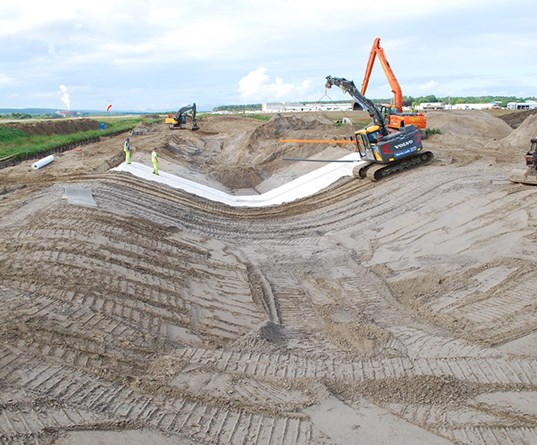Helping one of Scotland's key airports to remain compliant with Scottish Environment Protection Agency (SEPA) requirements, we have delivered improvements and upgrades to the primary surface water drainage swales at Inverness Airport.
Due to historic drainage issues at the airport, we were commissioned to carry out surface treatment and drainage works by Highlands and Islands Airport Limited (HIAL) via the SCAPE Scotland Civil Engineering framework.
Scope of works
Swales are the primary collection points for surface water drainage at the airport. Works delivered to improve and upgrade the existing swales included:
- Installing an impermeable liner in 10 existing swales to mitigate ground water contamination
- Widening of two swales upstream of the north reed bed to provide additional storage from water re-circulated from the reed bed treatment facility
- The diversion of two existing rising mains used to recirculate run-off requiring further treatment
- Installation of new headwalls and associated drain connections as well as a new three-pipe culvert crossing between the two widened swales
- Reuse of excavated material by re-profiling adjacent landscaped areas
- Working closely with SEPA to make sure legislative requirements were met.

Delivering biodiversity net gains
The airport is in an environmentally sensitive area that is rich in wildlife and ecosystems. As part of our offering on all SCAPE Scotland Civil Engineering projects, we assessed the impact of works on the biodiversity of the area and offered options to create a biodiversity net gain.
Our initial assessment identified that without mitigation, an 8.5% biodiversity loss would occur as a result of the project. Working collaboratively with Highlands and Islands Airports and NatureScot, we clearly set out how to avoid this and how to create a 5% biodiversity net gain, with the net gain being achieved through using a bespoke seed mix of plants genetically suited to the local environment.
Positive social impact
With HIAL’s contracted requirement to benefit the local community – both during and after construction - and our own well-established approach to generating social value, our project team designed a bespoke social impact action plan. The plan focussed on key areas including:
- Local regional spend
- Creation of local job opportunities
- Supporting young people into work
- Offering meaningful work experience placements
- Volunteering to support local community projects.
As a result of the plan and our well-established approach to generating social value we have been able to:
social value generated
spend with SME's
local labour
- Generate a 33% social value add for every £1 spent
- Ensure 100% of our spend was with SME’s
- Employ 97% of our workforce within 40 miles of the project
- Receive a Considerate Constructors scheme score of 42, earning a certificate of excellence for our focus on the local community and high standards delivered by our project team
- Create 7 weeks of work experience placements
- Provide 12 hours of support for young people looking to progress into employment
Alongside this, our teams also looked for innovative ways to ensure we reduced our environmental impact and carbon emissions. Utilising a hybrid solar pod generator to power one of the remote site compounds situated between the airport runway and taxiway, we saved 21.2 tonnes of C02, 7,678 litres of diesel and reduced noise pollution.
Collaborating for success
Working in a highly regulated and controlled aviation environment required meticulous planning to ensure safe, compliant airside working practices were followed.
Collaboration and regular communication with airport operations, air traffic control, Bristow’s Search and Rescue (SAR), and the Scottish Air Ambulance was also vital to ensuring the airport and vital emergency services remained operational at all times.